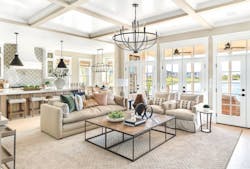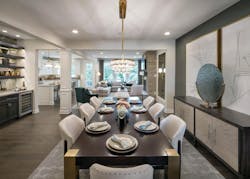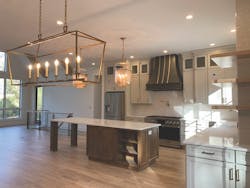Design experts will often refer to lighting as the jewelry of a home. When used effectively, lighting creates focal points to draw one’s attention to key characteristics. It can also serve as artwork, alter moods, and even enhance health and well-being.
Similar to how some jewelry will eventually lose its luster, residential lighting styles and techniques are continually evolving. Forward-thinking industry professionals and home owners who want to differentiate their homes from others should consider infusing some of the latest lighting trends.
Be Bold
Oftentimes, the focal point of a room is not an object on which the light is shining; rather, it’s the light fixture itself, according to Doris Pearlman, President of Possibilities for Design in Denver.
“The never-ending options of fixture styles and sizes to choose from offer people limitless opportunities to express themselves,” Pearlman said. “There are so many different ways you can use lighting to create effect, define a space, and make a room unique. Lighting used to be primarily just for function, and now it’s a distinguishing design technique.”
When selecting fixtures, Pearlman says it’s okay to be bold and encourages the use of diverse styles and materials. Lately, she has noticed the industry favoring the use of larger fixtures, grouped configurations and more prominent placement.
“A well-scaled light fixture can serve as a fantastic centerpiece for nearly any room,” Pearlman said. “Using two or even three fixtures at the center of a room can create a dramatic effect. And in bathrooms, for example, you no longer use just a simple bar light over a mirror; you can also hang pendants to create effect and make the space more interesting.”The reliance on lighting as decoration has increased recently as newer homes tend to feature more windows, leaving less wall space for artwork, according to Lita Dirks, CEO and Principal of Lita Dirks and Co. in Greenwood Village, Colo.
“Pieces of furniture like a sofa or chair, for example, won’t often make a big enough impact,” Dirks said. “But with lighting, it’s much easier to showcase one’s creativity and individuality. A beautifully sculpted, specialty light fixture is a fantastic way to create that drama, and then you can layer in more delicate light sources throughout the room.”
Subtle Surprise
In contrast to large fixtures with daring designs, light sources integrated into ceilings, behind wall hangings, and above and below cabinets can create simple wow factors.
“There’s a big trend toward linear applications, especially in the kitchen,” said John Newton, President of Newton Lighting Enterprises in Spencerport, N.Y. “Embedding long strips of LEDs within the ceiling creates a clean, seamless design. And they can take the place of a series of can lights for an even more modern look.”
Newton is also a proponent of finding ways to highlight items in the home that might otherwise be overlooked. Underlit kitchen islands and cabinets, and backlit bathroom mirrors add emphasis by creating a floating effect.
And for the aging-in-place market, Newton says the most critical element is proper bathroom lighting.“As people get older, bathroom trips become more frequent at night, so it’s definitely worth the investment to add lighting solutions to make it safer and more convenient,” Newton said. “But that doesn’t mean the bathroom should be overly bright, because when it’s the middle of the night and you’re done using the bathroom, ideally you want to get back to sleep.”
The secret, he says, is to install an automated LED strip at a low level of brightness underneath the toe kick of the vanity.
The angled light will gently graze the floor, reflecting just the right amount of nighttime illumination.
Look to Nature for Lighting Inspiration
When it comes to lighting, the initial focus is often placed on fixtures, lamps and recessed lights. However, many design experts agree that windows actually have the broadest impact on a home’s ambiance and comfort.
This is especially true in the wake of the COVID-19 pandemic. As more people are spending increased time at home, they are progressively looking for ways to connect their living spaces with the outdoors.
In 2020, the America at Home study was developed by several home and community development experts from Dahlin Group Architecture Planning, tst ink LLC and Strategic Solutions Alliance. The study surveyed a total of nearly 7,000 consumers nationwide to better understand how their home design preferences may have changed in light of COVID-19.
“The study confirmed that one of the top things people are looking for in a home is abundant natural light, and they’re increasingly conscious of its effect on emotional and physical well-being,” said Donald Ruthroff, AIA, Principal and Senior Architect at Dahlin Group in Pleasanton, Calif.
But more doesn’t always mean better when it comes to windows and natural light, Ruthroff added. The key is determining the ideal size and placement of the windows based on a home’s layout and location. Allowing for different angles of light at different times of the day will add character and balance to the space.
To optimize natural light in both new and existing homes, Ruthroff has seen a rise in the popularity of casement windows. Unlike sliding windows, casement windows do not have a bar in the middle and allow for a cleaner, more contemporary look without obstructions.
Ruthroff also suggests using taller windows with lower sills, thereby increasing the amount of light at the floor level. Doing so will make a space look more attractive and feel less closed off from the outdoors.
Once considered by many as merely optional, high-quality lighting packages and applications have emerged as must-haves for today’s well-designed homes. With the right strategy and a little creativity, even the dimmest homes can transform into dazzling jewels.




